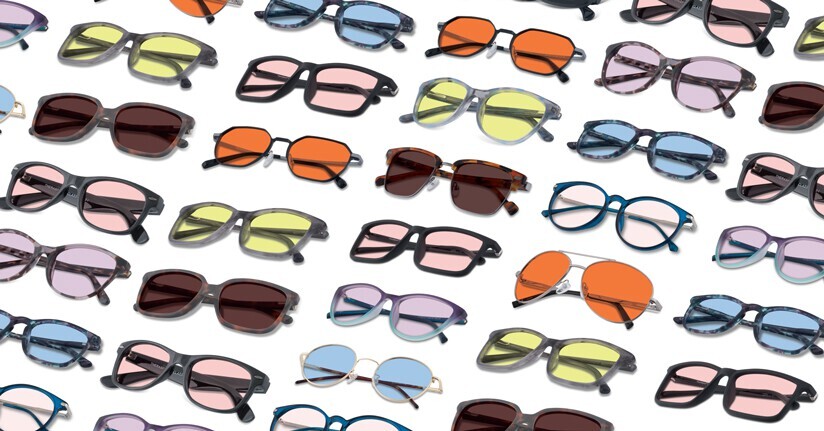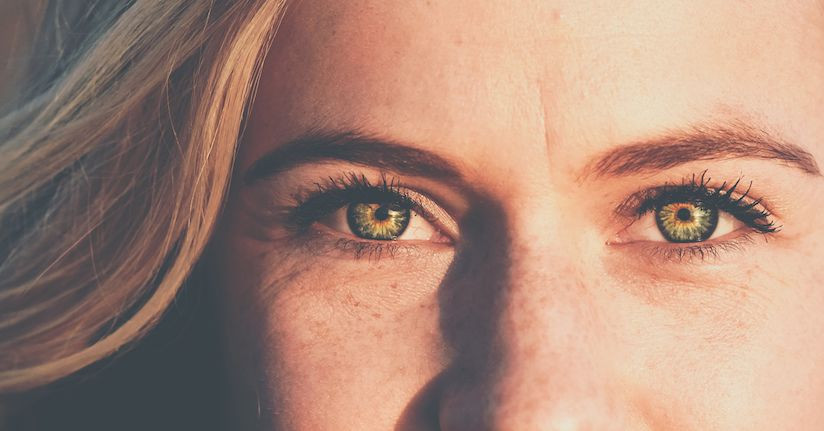9 Common Eye Symptoms after Concussion
Key Highlights
- There can be a constellation of eye symptoms after a concussion, and they can affect up to 82% of people after the injury
- Common symptoms include blurred or double vision, eye pain, light sensitivity, dry eye, and sensitivity to motion
- Light sensitivity is the second most common concussion symptom and is often triggered or worsened by screens and bright lighting
- Proper diagnosis, along with behavioral and lifestyle changes (including light-filtering concussion glasses), can help manage visual symptoms and discomfort
For those who have experienced any type of head trauma that results in a concussion or post-concussion syndrome, you probably are well aware that there can be numerous eye-related problems that result. Eye symptoms are frequently reported after a concussion, and studies have found that vision problems may affect 69% to 82% of people after a concussion, regardless of age.1-2
The most common eye problems include:
- Blurred or double vision
- Sensitivity to light and photophobia
- Partial vision loss
- Visual snow
- Eye or ocular pain
- Dry eye
- Abnormal eye movements
- Visual motion sensitivity
- Misalignment of eyes (vertical heterophoria)
Some of these may directly affect ocular function while others may be part of an impairment with vestibular or neurological systems—which ultimately causes the eye or vision issues. (Think post-concussion headaches which also leads to eye pain and light sensitivity, for example.) Regardless, we explore each of these symptoms in depth below.
Blurred or double vision
Blurry or double vision (diplopia) is a common complaint after a concussion and may result from damage to the muscles and/or nerves around the eye. This can stem from what is known as convergence insufficiency; in effect, the alignment of the eyes diverge when trying to focus on nearby objects.
Double or blurred vision after a head injury might also indicate a more serious neurological disorder, such as migraine with aura or vestibular migraine. In addition, this can result in other physical or cognitive consequences such as: dizziness; poor balance; eyestrain; difficulty reading or concentrating; and photophobia.
Light sensitivity and photophobia
Photophobia, or sensitivity to light, is considered the second most common symptom of a concussion and can be worsened by specific light sources, such as bright sunlight and fluorescent lighting. Recent studies have also suggested that LCD screens (such as from computers or smartphone devices) can be particularly harmful for light sensitivity after a brain injury.
The force of the trauma can cause displacement, irritation, or injury in several pain-sensitive brain-related structures.3-4 This may also explain the high prevalence of concussion-related headache disorders as well, which also can contribute to a person’s sensory sensitivities.
Read more: Post-concussion light sensitivity ➜
Vision loss
Partial or complete loss of vision can also occur as a result of head trauma, often taking on different forms depending on the person. For instance, you might experience blind spots in the periphery or have reduced vision in one half of the visual field.
This can be caused by several factors. In some cases, direct injury to the eye may be visible and indicated by lacerations, bruising, broken blood vessels, and swelling in the area. Although less common, vision loss can also be neurological in origin—represented by trauma to the main optic nerve in the back of the eye, or brain dysfunction that affects the visual pathway.5
Visual snow
More recently, there has been growing evidence that visual snow (and visual snow syndrome) may result from traumatic brain injuries.6 The predominant symptom is the presence of static or little dots in your vision, although other common symptoms associated with visual snow include floaters (seeing shapes) or afterimages (image persists or trails as it moves/exits the visual field). Night blindness or impaired nighttime vision also has roots in post-concussion visual snow.7

Eye (ocular) pain
Sometimes the eyes just hurt, whether it is a stabbing pain, a dull ache in or around the eye, or even redness, burning and itchiness. The trauma that caused the concussion can sometimes create what is known as an accommodation spasm which can make the eye hurt. This is when one of the muscles around the eye contracts and stays contracted for an extended period of time. Other muscle inflammation as well as light exposure (for a photophobic or inherently light-sensitive patient) can also lead to eye pain after a mild traumatic brain injury.
Dry eye
Concussions appear to carry a higher risk for the development of dry eye.8 In addition to dryness and irritation (especially due to environmental factors), symptoms such as eye pain, excessive squinting, lower tear production, redness, and eye fatigue are frequent complaints. Sensitivity to light also accompanies dry eye, as it does many of the symptoms on this list, which further complicates matters.
Abnormal eye movements
Weakened, delayed or otherwise abnormal eye movements are also frequently present for patients and are particularly noticeable for those with persistent post-concussion syndrome. The ability to track and focus on moving objects (pursuit eye movements) or scan and shift visual focus from one object to another (saccades) are the most prominent deficits observed by researchers. Gaze stability, which refers to the eye’s ability to maintain focus while the head is moving, can also be brought on by head trauma.9
There are many experts who suggest that these issues are some of the earliest diagnostic markers for post-concussion syndrome or a more severe traumatic brain injury. Unfortunately, ocular issues have been associated with worsening outcomes (like higher symptom burden and impaired daily living) for some post-concussion patients.10

Visual motion sensitivity
Concussed patients often report that they feel disoriented or uncomfortable and/or have other symptoms (e.g. vertigo) triggered by busy or disorienting environments. This is specifically referred to as visual motion sensitivity and is thought to be caused by dysfunction of the central nervous system that limits the patient’s ability to process complex external stimuli.10
Misalignment of eyes (vertical heterophoria)
Vertical heterophoria occurs when the eyes are misaligned vertically, meaning one eye is usually higher than the other. The eyes will try to compensate which can bring about strain or fatigue in the eye muscles. Vertical heterophoria can also make the patient see double, feel dizzy, or experience headaches or eye pain. Although it is unclear if mild traumatic brain injuries directly lead to it, experts believe it can be made worse by a head injury.
Tips for Managing Post-Concussion Eye Symptoms
After a concussion, visual symptoms like blurred vision, light sensitivity, eye pain, or abnormal eye movements should be carefully evaluated by a healthcare professional, ideally one experienced in post-concussion care. Prompt diagnosis is essential to rule out serious issues and guide effective treatment.
Glasses with specialized lenses can help manage light sensitivity after a concussion and visual motion discomfort. Additional therapies—such as vision rehabilitation, artificial tears for dry eye, and rest from visually demanding tasks—may also support recovery. Behavioral strategies may also help, such as limiting exposure to irritants like screens or bright lights and dry or dusty environments that are known to worsen symptoms.
Related reading: Concussions
6 Tips for Concussion and Post-Concussion Syndrome Recovery
12 Likely Symptoms of Post-Concussion Syndrome
Dizziness and Vertigo from Post-Concussion Syndrome
5 Types of Chronic Headaches and Migraines after TBI
Related reading: Concussions and Light Sensitivity
Post-Concussion Syndrome and Light Sensitivity
Light Sensitivity, Photophobia After Traumatic Brain Injuries
The BEST Blue Light Blocking Glasses for Migraine, Concussions, and Photophobia
Light Sensitivity and Dizziness
References:
1 Gallaway M, Scheiman M, Mitchell GL. Vision Therapy for Post-Concussion Vision Disorders. Optom Vis Sci. 2017 Jan;94(1):68-73. doi: 10.1097/OPX.0000000000000935.
2 Master CL, Scheiman M, Gallaway M, Goodman A, Robinson RL, Master SR, Grady MF. Vision Diagnoses Are Common After Concussion in Adolescents. Clin Pediatr (Phila). 2016 Mar;55(3):260-7. doi: 10.1177/0009922815594367. Epub 2015 Jul 7.
3 The Impact of LCD Screens on Post-Concussion Syndrome. 1 Aug 2017. Retrieved from www.theraspecs.com/blog/lcd-screens-post-concussion-syndrome.
4 Digre KB, Brennan KC. Shedding Light on Photophobia. Journal of neuro-ophthalmology : the official journal of the North American Neuro-Ophthalmology Society. 2012;32(1):68-81. doi:10.1097/WNO.0b013e3182474548.
5 Atkins EJ, Newman NJ, Biousse V. Post-Traumatic Visual Loss. Reviews in neurological diseases. 2008;5(2):73-81.
6 Rauchman SH, Zubair A, Jacob B, et al. Traumatic brain injury: Mechanisms, manifestations, and visual sequelae. Front Neurosci. 2023;17:1090672. Published 2023 Feb 23. doi:10.3389/fnins.2023.1090672
7 Puledda F, Schankin C, Goadsby PJ. Visual snow syndrome: A clinical and phenotypical description of 1,100 cases. Neurology. 2020;94(6):e564-e574. doi:10.1212/WNL.0000000000008909
8 Lee CJ, Felix ER, Levitt RC, et al. Traumatic brain injury, dry eye and comorbid pain diagnoses in US veterans. Br J Ophthalmol. 2018;102(5):667-673. doi:10.1136/bjophthalmol-2017-310509
9 Broglio SP, Collins MW, Williams RM, Mucha A, Kontos A. Current and emerging rehabilitation for concussion: A review of the evidence. Clinics in sports medicine. 2015;34(2):213-231. doi:10.1016/j.csm.2014.12.005.
10 Heitger MH, Jones RD, Macleod AD, Snell DL, Frampton CM, Anderson TJ. Impaired eye movements in post-concussion syndrome indicate suboptimal brain function beyond the influence of depression, malingering or intellectual ability. Brain. 2009 Oct;132(Pt 10):2850-70. doi: 10.1093/brain/awp181. Epub 2009 Jul 16.
Last updated 7th Aug 2025

TheraSpecs® Glasses for Light Sensitivity
Find the glasses that fit your needs and lifestyle, and stay protected from screens, fluorescents, unwanted blue light, sunlight, flashing lights, and more.
Shop Now





